Reflection on Therapeutic Relationships & NMBA Code of Conduct
VerifiedAdded on 2023/06/12
|9
|2087
|320
Essay
AI Summary
This essay is a reflection on the experience of establishing therapeutic and professional relationships in nursing practice, utilizing Gribb's reflective model. The reflection centers around an event involving the vital sign assessment of a patient, highlighting the importance of maintaining Standard 2 of the NMBA code of conduct. The author reflects on the positive aspects of the observed interaction, such as the nursing professional's polite and respectful behavior, positive attitude, and effective communication strategies, which helped build trust and rapport with the patient. The reflection acknowledges a negative aspect where the nurse didn't address the patient's concerns adequately. The analysis emphasizes the significance of therapeutic relationships in ensuring patient safety, respecting patient rights, and promoting effective person-centered care. The author concludes by outlining an action plan to improve skills through further learning about the NMBA code of conduct, communication skill workshops, and evidence-based articles on therapeutic relationships in nursing.
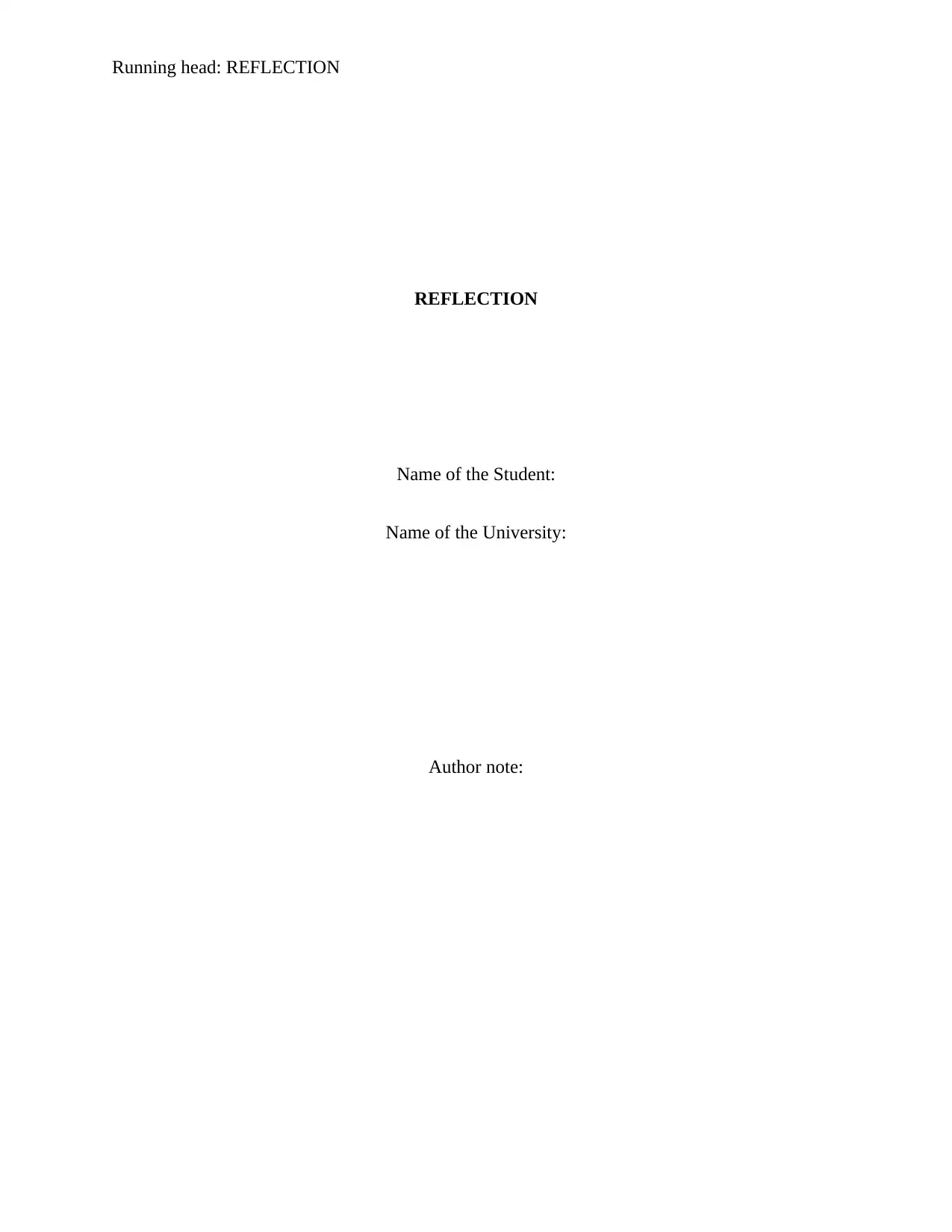
Running head: REFLECTION
REFLECTION
Name of the Student:
Name of the University:
Author note:
REFLECTION
Name of the Student:
Name of the University:
Author note:
Paraphrase This Document
Need a fresh take? Get an instant paraphrase of this document with our AI Paraphraser
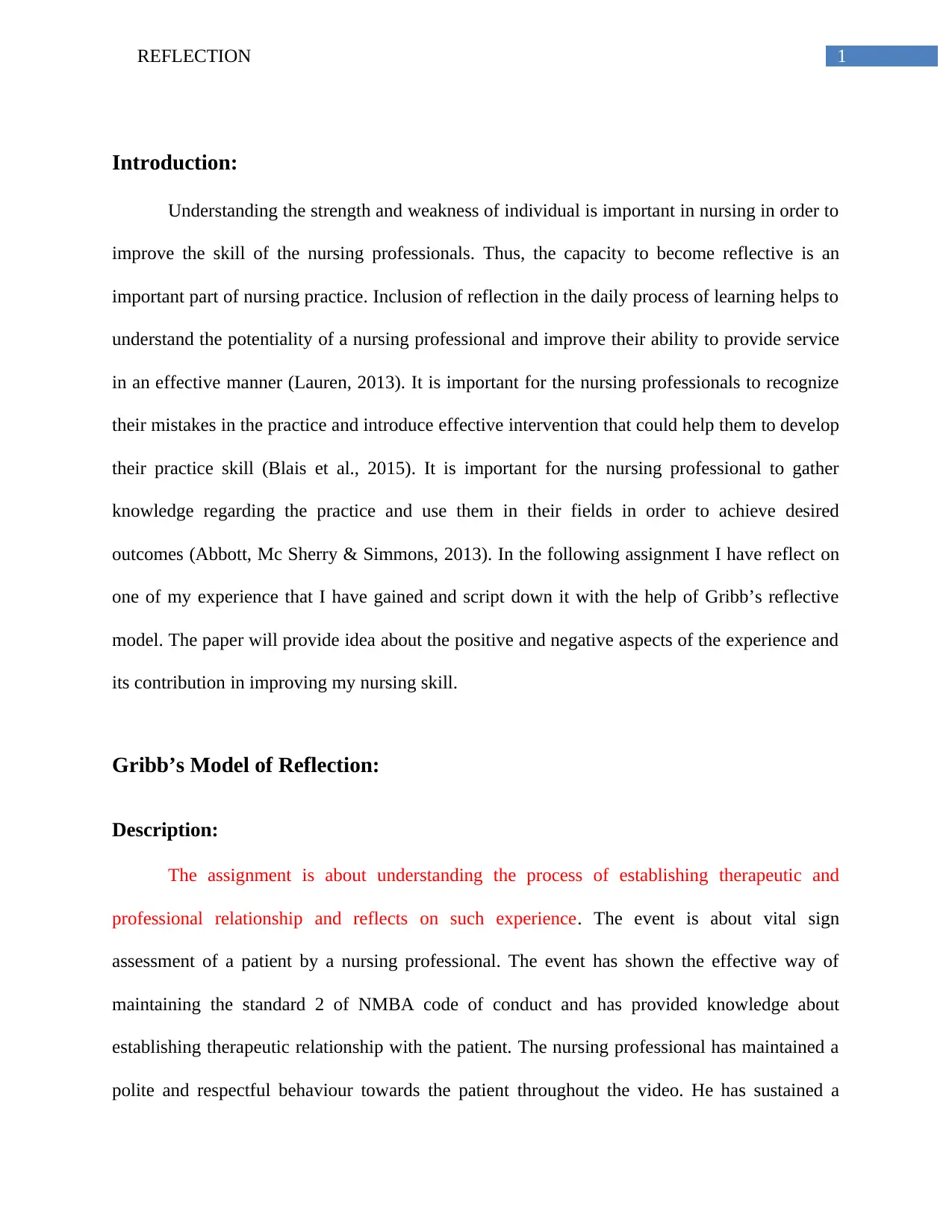
1REFLECTION
Introduction:
Understanding the strength and weakness of individual is important in nursing in order to
improve the skill of the nursing professionals. Thus, the capacity to become reflective is an
important part of nursing practice. Inclusion of reflection in the daily process of learning helps to
understand the potentiality of a nursing professional and improve their ability to provide service
in an effective manner (Lauren, 2013). It is important for the nursing professionals to recognize
their mistakes in the practice and introduce effective intervention that could help them to develop
their practice skill (Blais et al., 2015). It is important for the nursing professional to gather
knowledge regarding the practice and use them in their fields in order to achieve desired
outcomes (Abbott, Mc Sherry & Simmons, 2013). In the following assignment I have reflect on
one of my experience that I have gained and script down it with the help of Gribb’s reflective
model. The paper will provide idea about the positive and negative aspects of the experience and
its contribution in improving my nursing skill.
Gribb’s Model of Reflection:
Description:
The assignment is about understanding the process of establishing therapeutic and
professional relationship and reflects on such experience. The event is about vital sign
assessment of a patient by a nursing professional. The event has shown the effective way of
maintaining the standard 2 of NMBA code of conduct and has provided knowledge about
establishing therapeutic relationship with the patient. The nursing professional has maintained a
polite and respectful behaviour towards the patient throughout the video. He has sustained a
Introduction:
Understanding the strength and weakness of individual is important in nursing in order to
improve the skill of the nursing professionals. Thus, the capacity to become reflective is an
important part of nursing practice. Inclusion of reflection in the daily process of learning helps to
understand the potentiality of a nursing professional and improve their ability to provide service
in an effective manner (Lauren, 2013). It is important for the nursing professionals to recognize
their mistakes in the practice and introduce effective intervention that could help them to develop
their practice skill (Blais et al., 2015). It is important for the nursing professional to gather
knowledge regarding the practice and use them in their fields in order to achieve desired
outcomes (Abbott, Mc Sherry & Simmons, 2013). In the following assignment I have reflect on
one of my experience that I have gained and script down it with the help of Gribb’s reflective
model. The paper will provide idea about the positive and negative aspects of the experience and
its contribution in improving my nursing skill.
Gribb’s Model of Reflection:
Description:
The assignment is about understanding the process of establishing therapeutic and
professional relationship and reflects on such experience. The event is about vital sign
assessment of a patient by a nursing professional. The event has shown the effective way of
maintaining the standard 2 of NMBA code of conduct and has provided knowledge about
establishing therapeutic relationship with the patient. The nursing professional has maintained a
polite and respectful behaviour towards the patient throughout the video. He has sustained a
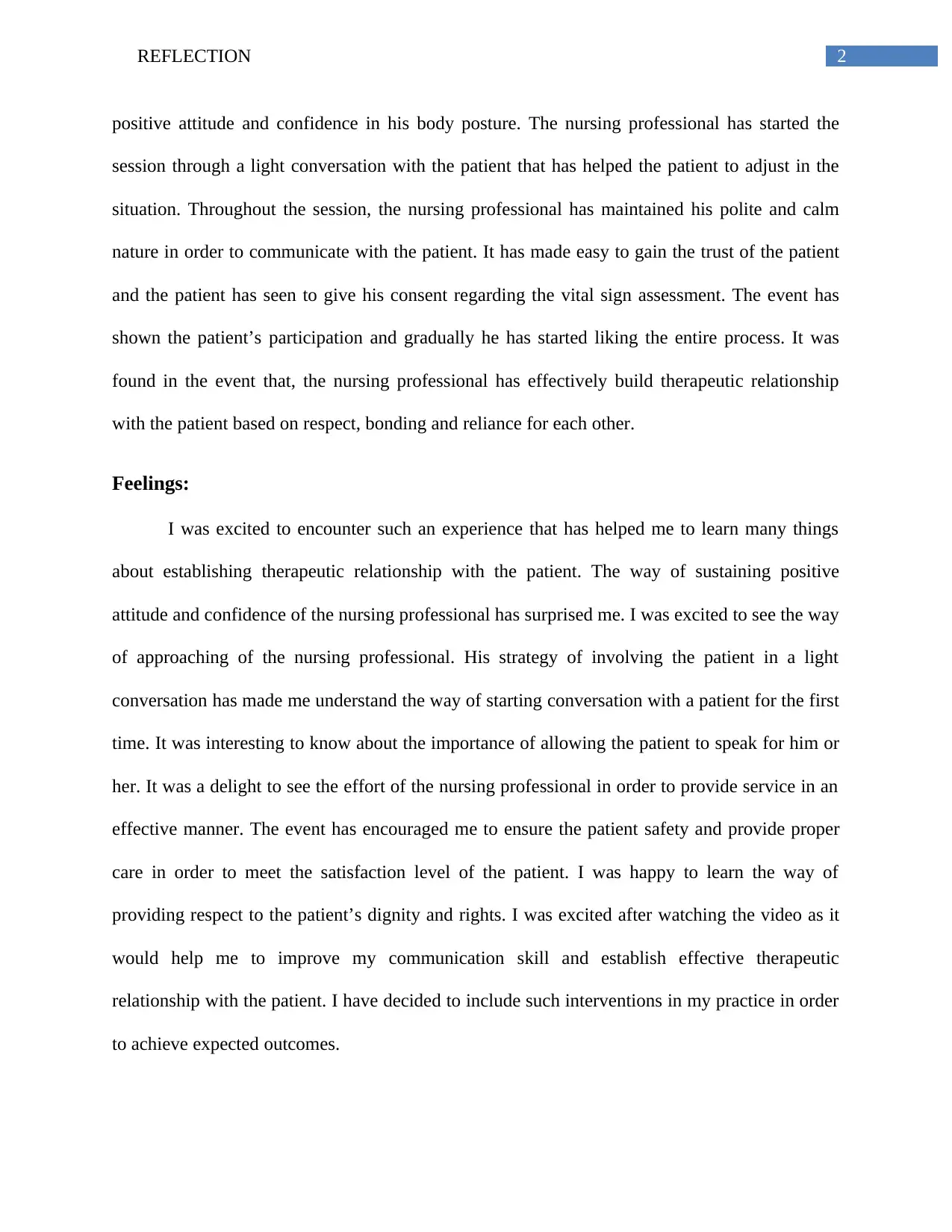
2REFLECTION
positive attitude and confidence in his body posture. The nursing professional has started the
session through a light conversation with the patient that has helped the patient to adjust in the
situation. Throughout the session, the nursing professional has maintained his polite and calm
nature in order to communicate with the patient. It has made easy to gain the trust of the patient
and the patient has seen to give his consent regarding the vital sign assessment. The event has
shown the patient’s participation and gradually he has started liking the entire process. It was
found in the event that, the nursing professional has effectively build therapeutic relationship
with the patient based on respect, bonding and reliance for each other.
Feelings:
I was excited to encounter such an experience that has helped me to learn many things
about establishing therapeutic relationship with the patient. The way of sustaining positive
attitude and confidence of the nursing professional has surprised me. I was excited to see the way
of approaching of the nursing professional. His strategy of involving the patient in a light
conversation has made me understand the way of starting conversation with a patient for the first
time. It was interesting to know about the importance of allowing the patient to speak for him or
her. It was a delight to see the effort of the nursing professional in order to provide service in an
effective manner. The event has encouraged me to ensure the patient safety and provide proper
care in order to meet the satisfaction level of the patient. I was happy to learn the way of
providing respect to the patient’s dignity and rights. I was excited after watching the video as it
would help me to improve my communication skill and establish effective therapeutic
relationship with the patient. I have decided to include such interventions in my practice in order
to achieve expected outcomes.
positive attitude and confidence in his body posture. The nursing professional has started the
session through a light conversation with the patient that has helped the patient to adjust in the
situation. Throughout the session, the nursing professional has maintained his polite and calm
nature in order to communicate with the patient. It has made easy to gain the trust of the patient
and the patient has seen to give his consent regarding the vital sign assessment. The event has
shown the patient’s participation and gradually he has started liking the entire process. It was
found in the event that, the nursing professional has effectively build therapeutic relationship
with the patient based on respect, bonding and reliance for each other.
Feelings:
I was excited to encounter such an experience that has helped me to learn many things
about establishing therapeutic relationship with the patient. The way of sustaining positive
attitude and confidence of the nursing professional has surprised me. I was excited to see the way
of approaching of the nursing professional. His strategy of involving the patient in a light
conversation has made me understand the way of starting conversation with a patient for the first
time. It was interesting to know about the importance of allowing the patient to speak for him or
her. It was a delight to see the effort of the nursing professional in order to provide service in an
effective manner. The event has encouraged me to ensure the patient safety and provide proper
care in order to meet the satisfaction level of the patient. I was happy to learn the way of
providing respect to the patient’s dignity and rights. I was excited after watching the video as it
would help me to improve my communication skill and establish effective therapeutic
relationship with the patient. I have decided to include such interventions in my practice in order
to achieve expected outcomes.
⊘ This is a preview!⊘
Do you want full access?
Subscribe today to unlock all pages.

Trusted by 1+ million students worldwide
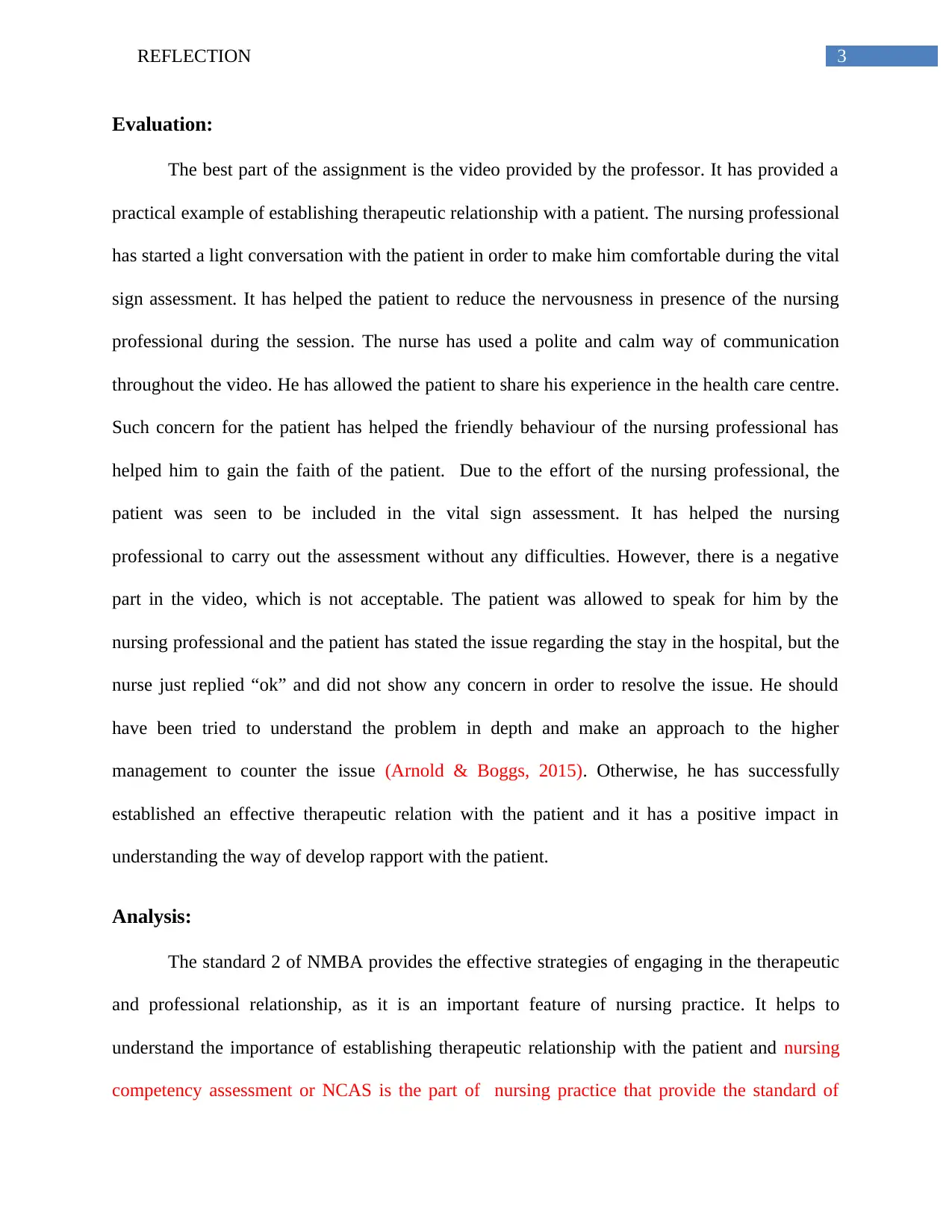
3REFLECTION
Evaluation:
The best part of the assignment is the video provided by the professor. It has provided a
practical example of establishing therapeutic relationship with a patient. The nursing professional
has started a light conversation with the patient in order to make him comfortable during the vital
sign assessment. It has helped the patient to reduce the nervousness in presence of the nursing
professional during the session. The nurse has used a polite and calm way of communication
throughout the video. He has allowed the patient to share his experience in the health care centre.
Such concern for the patient has helped the friendly behaviour of the nursing professional has
helped him to gain the faith of the patient. Due to the effort of the nursing professional, the
patient was seen to be included in the vital sign assessment. It has helped the nursing
professional to carry out the assessment without any difficulties. However, there is a negative
part in the video, which is not acceptable. The patient was allowed to speak for him by the
nursing professional and the patient has stated the issue regarding the stay in the hospital, but the
nurse just replied “ok” and did not show any concern in order to resolve the issue. He should
have been tried to understand the problem in depth and make an approach to the higher
management to counter the issue (Arnold & Boggs, 2015). Otherwise, he has successfully
established an effective therapeutic relation with the patient and it has a positive impact in
understanding the way of develop rapport with the patient.
Analysis:
The standard 2 of NMBA provides the effective strategies of engaging in the therapeutic
and professional relationship, as it is an important feature of nursing practice. It helps to
understand the importance of establishing therapeutic relationship with the patient and nursing
competency assessment or NCAS is the part of nursing practice that provide the standard of
Evaluation:
The best part of the assignment is the video provided by the professor. It has provided a
practical example of establishing therapeutic relationship with a patient. The nursing professional
has started a light conversation with the patient in order to make him comfortable during the vital
sign assessment. It has helped the patient to reduce the nervousness in presence of the nursing
professional during the session. The nurse has used a polite and calm way of communication
throughout the video. He has allowed the patient to share his experience in the health care centre.
Such concern for the patient has helped the friendly behaviour of the nursing professional has
helped him to gain the faith of the patient. Due to the effort of the nursing professional, the
patient was seen to be included in the vital sign assessment. It has helped the nursing
professional to carry out the assessment without any difficulties. However, there is a negative
part in the video, which is not acceptable. The patient was allowed to speak for him by the
nursing professional and the patient has stated the issue regarding the stay in the hospital, but the
nurse just replied “ok” and did not show any concern in order to resolve the issue. He should
have been tried to understand the problem in depth and make an approach to the higher
management to counter the issue (Arnold & Boggs, 2015). Otherwise, he has successfully
established an effective therapeutic relation with the patient and it has a positive impact in
understanding the way of develop rapport with the patient.
Analysis:
The standard 2 of NMBA provides the effective strategies of engaging in the therapeutic
and professional relationship, as it is an important feature of nursing practice. It helps to
understand the importance of establishing therapeutic relationship with the patient and nursing
competency assessment or NCAS is the part of nursing practice that provide the standard of
Paraphrase This Document
Need a fresh take? Get an instant paraphrase of this document with our AI Paraphraser
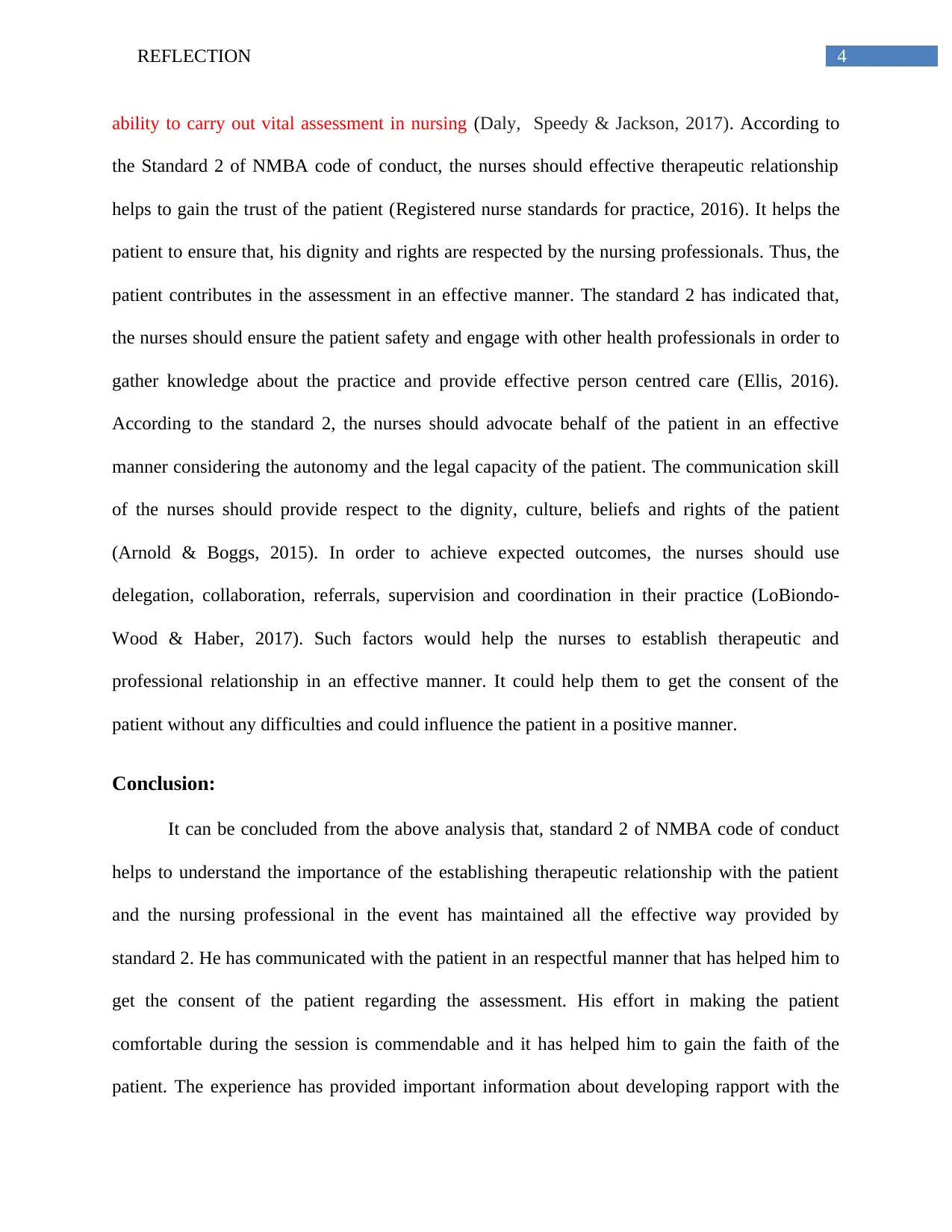
4REFLECTION
ability to carry out vital assessment in nursing (Daly, Speedy & Jackson, 2017). According to
the Standard 2 of NMBA code of conduct, the nurses should effective therapeutic relationship
helps to gain the trust of the patient (Registered nurse standards for practice, 2016). It helps the
patient to ensure that, his dignity and rights are respected by the nursing professionals. Thus, the
patient contributes in the assessment in an effective manner. The standard 2 has indicated that,
the nurses should ensure the patient safety and engage with other health professionals in order to
gather knowledge about the practice and provide effective person centred care (Ellis, 2016).
According to the standard 2, the nurses should advocate behalf of the patient in an effective
manner considering the autonomy and the legal capacity of the patient. The communication skill
of the nurses should provide respect to the dignity, culture, beliefs and rights of the patient
(Arnold & Boggs, 2015). In order to achieve expected outcomes, the nurses should use
delegation, collaboration, referrals, supervision and coordination in their practice (LoBiondo-
Wood & Haber, 2017). Such factors would help the nurses to establish therapeutic and
professional relationship in an effective manner. It could help them to get the consent of the
patient without any difficulties and could influence the patient in a positive manner.
Conclusion:
It can be concluded from the above analysis that, standard 2 of NMBA code of conduct
helps to understand the importance of the establishing therapeutic relationship with the patient
and the nursing professional in the event has maintained all the effective way provided by
standard 2. He has communicated with the patient in an respectful manner that has helped him to
get the consent of the patient regarding the assessment. His effort in making the patient
comfortable during the session is commendable and it has helped him to gain the faith of the
patient. The experience has provided important information about developing rapport with the
ability to carry out vital assessment in nursing (Daly, Speedy & Jackson, 2017). According to
the Standard 2 of NMBA code of conduct, the nurses should effective therapeutic relationship
helps to gain the trust of the patient (Registered nurse standards for practice, 2016). It helps the
patient to ensure that, his dignity and rights are respected by the nursing professionals. Thus, the
patient contributes in the assessment in an effective manner. The standard 2 has indicated that,
the nurses should ensure the patient safety and engage with other health professionals in order to
gather knowledge about the practice and provide effective person centred care (Ellis, 2016).
According to the standard 2, the nurses should advocate behalf of the patient in an effective
manner considering the autonomy and the legal capacity of the patient. The communication skill
of the nurses should provide respect to the dignity, culture, beliefs and rights of the patient
(Arnold & Boggs, 2015). In order to achieve expected outcomes, the nurses should use
delegation, collaboration, referrals, supervision and coordination in their practice (LoBiondo-
Wood & Haber, 2017). Such factors would help the nurses to establish therapeutic and
professional relationship in an effective manner. It could help them to get the consent of the
patient without any difficulties and could influence the patient in a positive manner.
Conclusion:
It can be concluded from the above analysis that, standard 2 of NMBA code of conduct
helps to understand the importance of the establishing therapeutic relationship with the patient
and the nursing professional in the event has maintained all the effective way provided by
standard 2. He has communicated with the patient in an respectful manner that has helped him to
get the consent of the patient regarding the assessment. His effort in making the patient
comfortable during the session is commendable and it has helped him to gain the faith of the
patient. The experience has provided important information about developing rapport with the
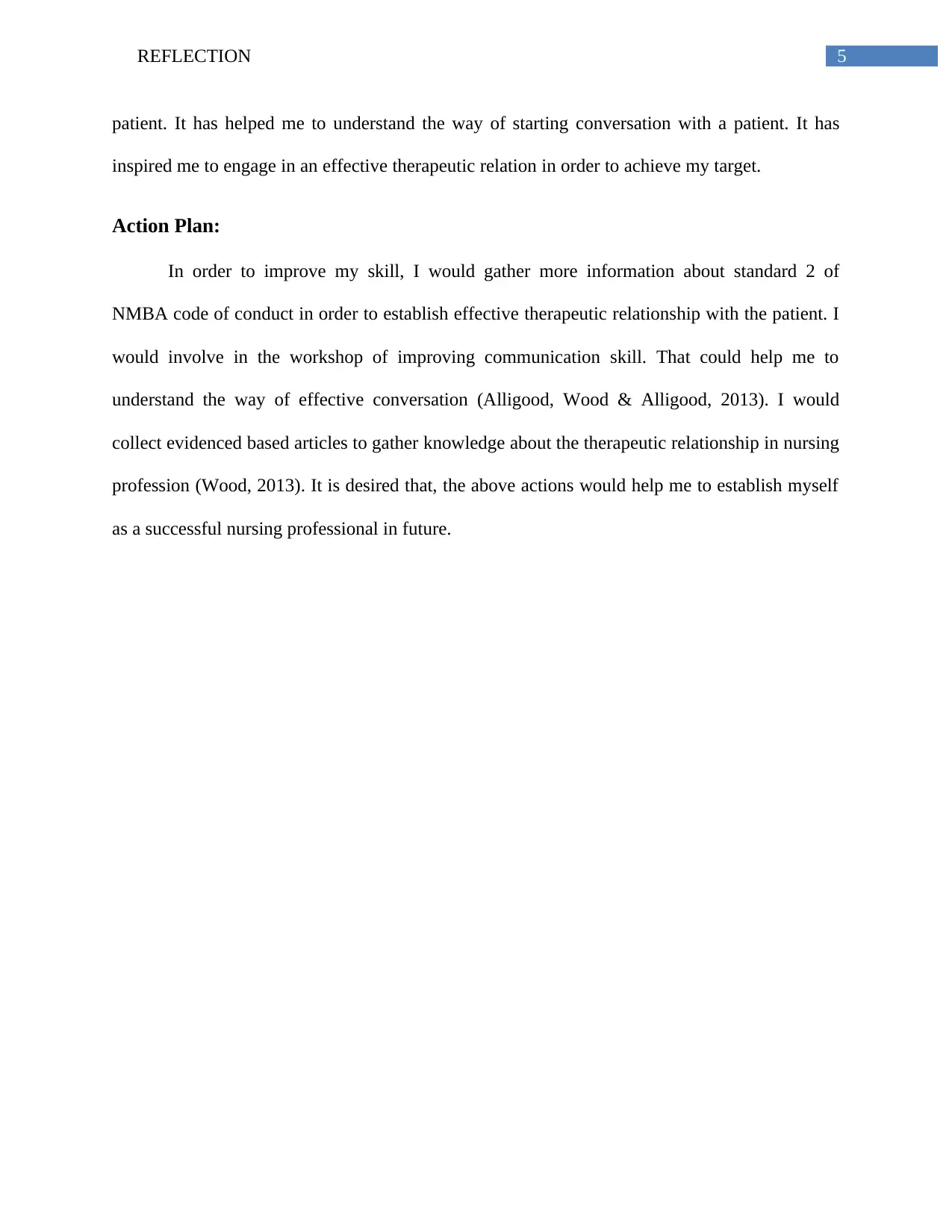
5REFLECTION
patient. It has helped me to understand the way of starting conversation with a patient. It has
inspired me to engage in an effective therapeutic relation in order to achieve my target.
Action Plan:
In order to improve my skill, I would gather more information about standard 2 of
NMBA code of conduct in order to establish effective therapeutic relationship with the patient. I
would involve in the workshop of improving communication skill. That could help me to
understand the way of effective conversation (Alligood, Wood & Alligood, 2013). I would
collect evidenced based articles to gather knowledge about the therapeutic relationship in nursing
profession (Wood, 2013). It is desired that, the above actions would help me to establish myself
as a successful nursing professional in future.
patient. It has helped me to understand the way of starting conversation with a patient. It has
inspired me to engage in an effective therapeutic relation in order to achieve my target.
Action Plan:
In order to improve my skill, I would gather more information about standard 2 of
NMBA code of conduct in order to establish effective therapeutic relationship with the patient. I
would involve in the workshop of improving communication skill. That could help me to
understand the way of effective conversation (Alligood, Wood & Alligood, 2013). I would
collect evidenced based articles to gather knowledge about the therapeutic relationship in nursing
profession (Wood, 2013). It is desired that, the above actions would help me to establish myself
as a successful nursing professional in future.
⊘ This is a preview!⊘
Do you want full access?
Subscribe today to unlock all pages.

Trusted by 1+ million students worldwide
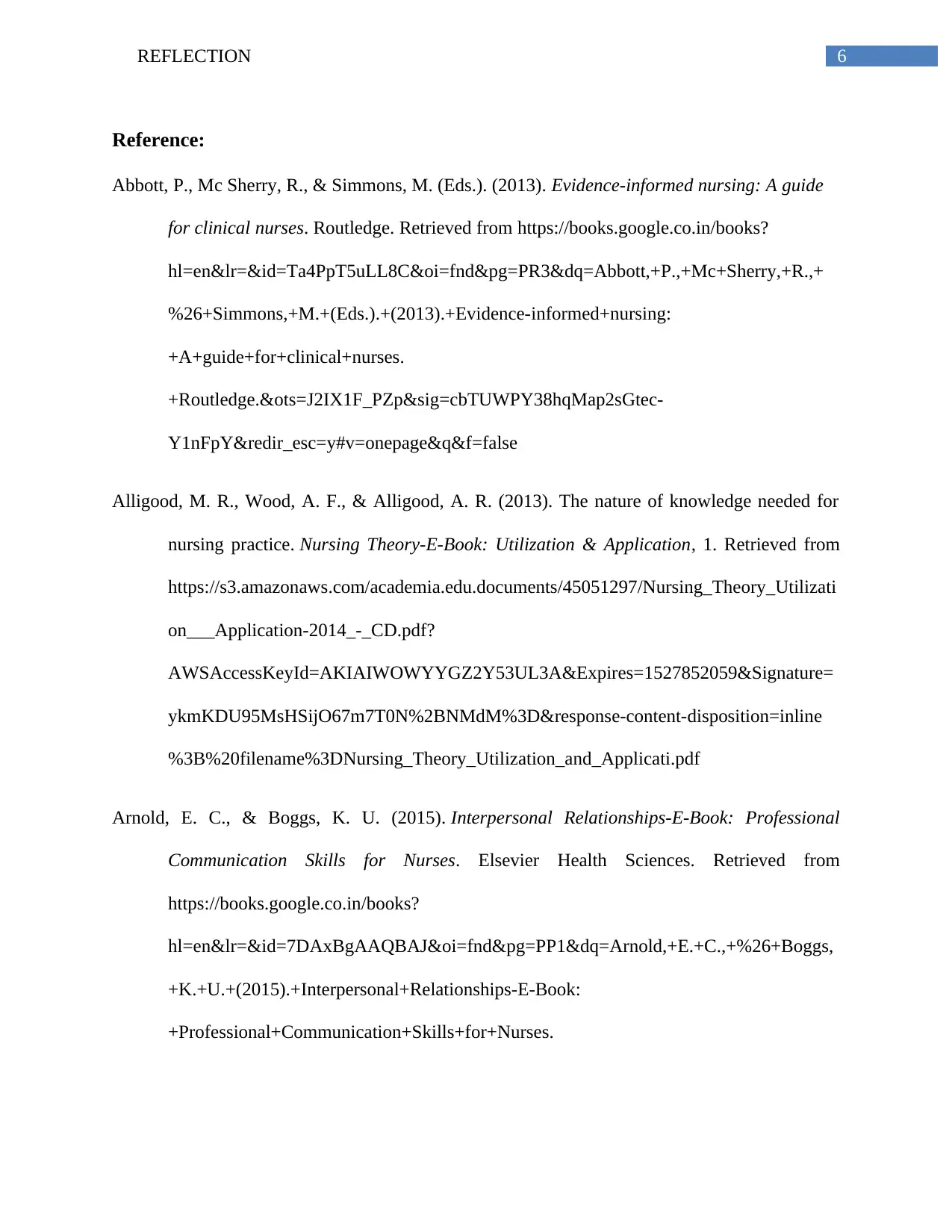
6REFLECTION
Reference:
Abbott, P., Mc Sherry, R., & Simmons, M. (Eds.). (2013). Evidence-informed nursing: A guide
for clinical nurses. Routledge. Retrieved from https://books.google.co.in/books?
hl=en&lr=&id=Ta4PpT5uLL8C&oi=fnd&pg=PR3&dq=Abbott,+P.,+Mc+Sherry,+R.,+
%26+Simmons,+M.+(Eds.).+(2013).+Evidence-informed+nursing:
+A+guide+for+clinical+nurses.
+Routledge.&ots=J2IX1F_PZp&sig=cbTUWPY38hqMap2sGtec-
Y1nFpY&redir_esc=y#v=onepage&q&f=false
Alligood, M. R., Wood, A. F., & Alligood, A. R. (2013). The nature of knowledge needed for
nursing practice. Nursing Theory-E-Book: Utilization & Application, 1. Retrieved from
https://s3.amazonaws.com/academia.edu.documents/45051297/Nursing_Theory_Utilizati
on___Application-2014_-_CD.pdf?
AWSAccessKeyId=AKIAIWOWYYGZ2Y53UL3A&Expires=1527852059&Signature=
ykmKDU95MsHSijO67m7T0N%2BNMdM%3D&response-content-disposition=inline
%3B%20filename%3DNursing_Theory_Utilization_and_Applicati.pdf
Arnold, E. C., & Boggs, K. U. (2015). Interpersonal Relationships-E-Book: Professional
Communication Skills for Nurses. Elsevier Health Sciences. Retrieved from
https://books.google.co.in/books?
hl=en&lr=&id=7DAxBgAAQBAJ&oi=fnd&pg=PP1&dq=Arnold,+E.+C.,+%26+Boggs,
+K.+U.+(2015).+Interpersonal+Relationships-E-Book:
+Professional+Communication+Skills+for+Nurses.
Reference:
Abbott, P., Mc Sherry, R., & Simmons, M. (Eds.). (2013). Evidence-informed nursing: A guide
for clinical nurses. Routledge. Retrieved from https://books.google.co.in/books?
hl=en&lr=&id=Ta4PpT5uLL8C&oi=fnd&pg=PR3&dq=Abbott,+P.,+Mc+Sherry,+R.,+
%26+Simmons,+M.+(Eds.).+(2013).+Evidence-informed+nursing:
+A+guide+for+clinical+nurses.
+Routledge.&ots=J2IX1F_PZp&sig=cbTUWPY38hqMap2sGtec-
Y1nFpY&redir_esc=y#v=onepage&q&f=false
Alligood, M. R., Wood, A. F., & Alligood, A. R. (2013). The nature of knowledge needed for
nursing practice. Nursing Theory-E-Book: Utilization & Application, 1. Retrieved from
https://s3.amazonaws.com/academia.edu.documents/45051297/Nursing_Theory_Utilizati
on___Application-2014_-_CD.pdf?
AWSAccessKeyId=AKIAIWOWYYGZ2Y53UL3A&Expires=1527852059&Signature=
ykmKDU95MsHSijO67m7T0N%2BNMdM%3D&response-content-disposition=inline
%3B%20filename%3DNursing_Theory_Utilization_and_Applicati.pdf
Arnold, E. C., & Boggs, K. U. (2015). Interpersonal Relationships-E-Book: Professional
Communication Skills for Nurses. Elsevier Health Sciences. Retrieved from
https://books.google.co.in/books?
hl=en&lr=&id=7DAxBgAAQBAJ&oi=fnd&pg=PP1&dq=Arnold,+E.+C.,+%26+Boggs,
+K.+U.+(2015).+Interpersonal+Relationships-E-Book:
+Professional+Communication+Skills+for+Nurses.
Paraphrase This Document
Need a fresh take? Get an instant paraphrase of this document with our AI Paraphraser
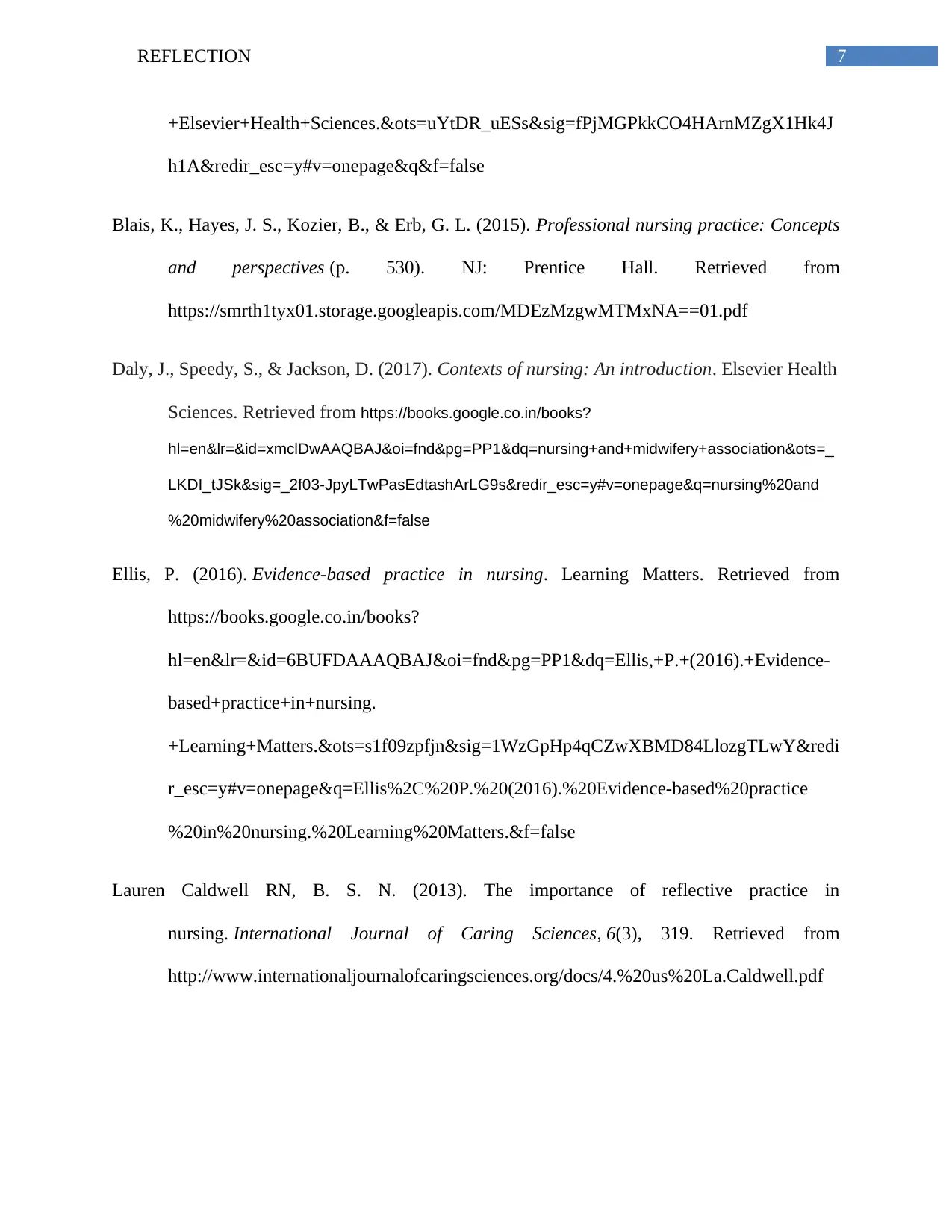
7REFLECTION
+Elsevier+Health+Sciences.&ots=uYtDR_uESs&sig=fPjMGPkkCO4HArnMZgX1Hk4J
h1A&redir_esc=y#v=onepage&q&f=false
Blais, K., Hayes, J. S., Kozier, B., & Erb, G. L. (2015). Professional nursing practice: Concepts
and perspectives (p. 530). NJ: Prentice Hall. Retrieved from
https://smrth1tyx01.storage.googleapis.com/MDEzMzgwMTMxNA==01.pdf
Daly, J., Speedy, S., & Jackson, D. (2017). Contexts of nursing: An introduction. Elsevier Health
Sciences. Retrieved from https://books.google.co.in/books?
hl=en&lr=&id=xmclDwAAQBAJ&oi=fnd&pg=PP1&dq=nursing+and+midwifery+association&ots=_
LKDI_tJSk&sig=_2f03-JpyLTwPasEdtashArLG9s&redir_esc=y#v=onepage&q=nursing%20and
%20midwifery%20association&f=false
Ellis, P. (2016). Evidence-based practice in nursing. Learning Matters. Retrieved from
https://books.google.co.in/books?
hl=en&lr=&id=6BUFDAAAQBAJ&oi=fnd&pg=PP1&dq=Ellis,+P.+(2016).+Evidence-
based+practice+in+nursing.
+Learning+Matters.&ots=s1f09zpfjn&sig=1WzGpHp4qCZwXBMD84LlozgTLwY&redi
r_esc=y#v=onepage&q=Ellis%2C%20P.%20(2016).%20Evidence-based%20practice
%20in%20nursing.%20Learning%20Matters.&f=false
Lauren Caldwell RN, B. S. N. (2013). The importance of reflective practice in
nursing. International Journal of Caring Sciences, 6(3), 319. Retrieved from
http://www.internationaljournalofcaringsciences.org/docs/4.%20us%20La.Caldwell.pdf
+Elsevier+Health+Sciences.&ots=uYtDR_uESs&sig=fPjMGPkkCO4HArnMZgX1Hk4J
h1A&redir_esc=y#v=onepage&q&f=false
Blais, K., Hayes, J. S., Kozier, B., & Erb, G. L. (2015). Professional nursing practice: Concepts
and perspectives (p. 530). NJ: Prentice Hall. Retrieved from
https://smrth1tyx01.storage.googleapis.com/MDEzMzgwMTMxNA==01.pdf
Daly, J., Speedy, S., & Jackson, D. (2017). Contexts of nursing: An introduction. Elsevier Health
Sciences. Retrieved from https://books.google.co.in/books?
hl=en&lr=&id=xmclDwAAQBAJ&oi=fnd&pg=PP1&dq=nursing+and+midwifery+association&ots=_
LKDI_tJSk&sig=_2f03-JpyLTwPasEdtashArLG9s&redir_esc=y#v=onepage&q=nursing%20and
%20midwifery%20association&f=false
Ellis, P. (2016). Evidence-based practice in nursing. Learning Matters. Retrieved from
https://books.google.co.in/books?
hl=en&lr=&id=6BUFDAAAQBAJ&oi=fnd&pg=PP1&dq=Ellis,+P.+(2016).+Evidence-
based+practice+in+nursing.
+Learning+Matters.&ots=s1f09zpfjn&sig=1WzGpHp4qCZwXBMD84LlozgTLwY&redi
r_esc=y#v=onepage&q=Ellis%2C%20P.%20(2016).%20Evidence-based%20practice
%20in%20nursing.%20Learning%20Matters.&f=false
Lauren Caldwell RN, B. S. N. (2013). The importance of reflective practice in
nursing. International Journal of Caring Sciences, 6(3), 319. Retrieved from
http://www.internationaljournalofcaringsciences.org/docs/4.%20us%20La.Caldwell.pdf
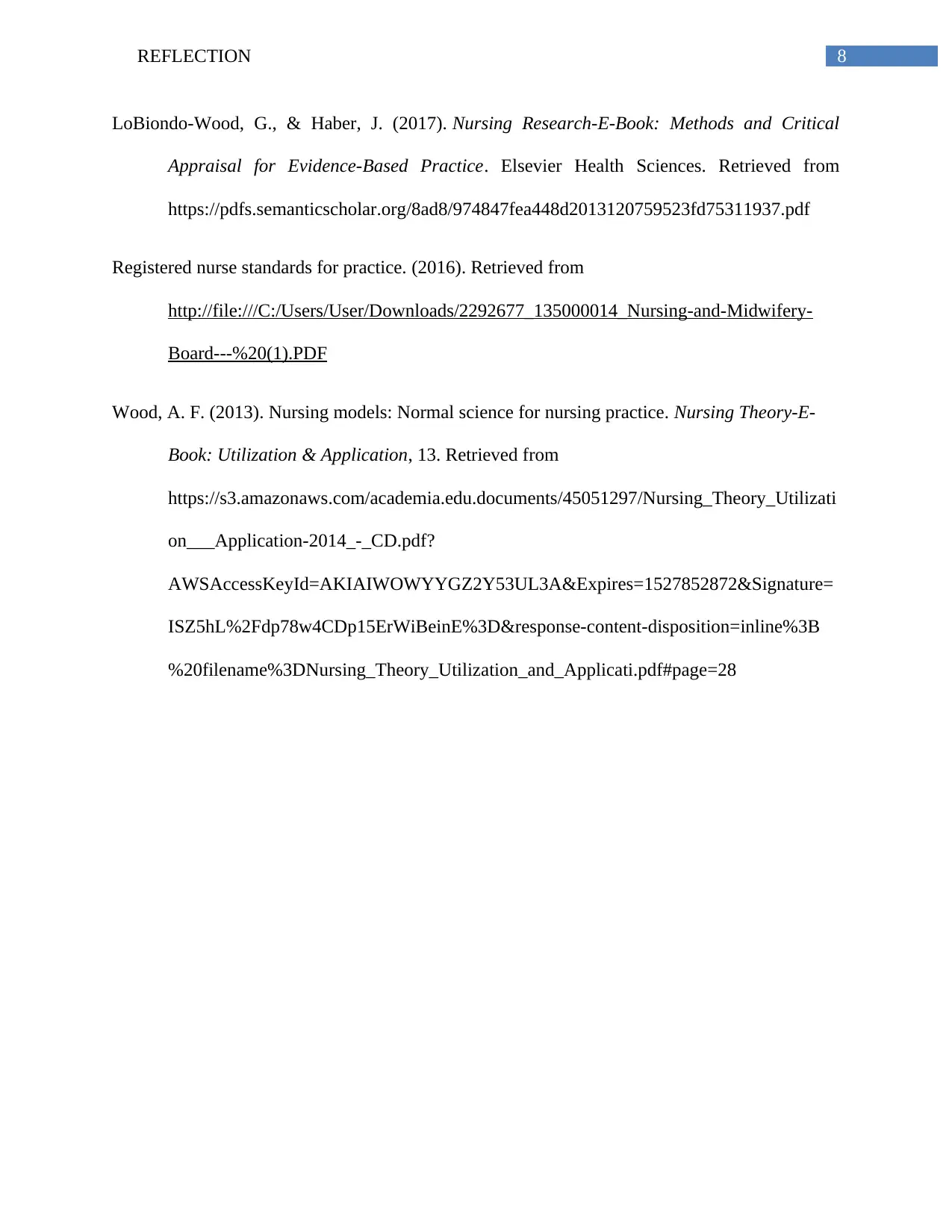
8REFLECTION
LoBiondo-Wood, G., & Haber, J. (2017). Nursing Research-E-Book: Methods and Critical
Appraisal for Evidence-Based Practice. Elsevier Health Sciences. Retrieved from
https://pdfs.semanticscholar.org/8ad8/974847fea448d2013120759523fd75311937.pdf
Registered nurse standards for practice. (2016). Retrieved from
http://file:///C:/Users/User/Downloads/2292677_135000014_Nursing-and-Midwifery-
Board---%20(1).PDF
Wood, A. F. (2013). Nursing models: Normal science for nursing practice. Nursing Theory-E-
Book: Utilization & Application, 13. Retrieved from
https://s3.amazonaws.com/academia.edu.documents/45051297/Nursing_Theory_Utilizati
on___Application-2014_-_CD.pdf?
AWSAccessKeyId=AKIAIWOWYYGZ2Y53UL3A&Expires=1527852872&Signature=
ISZ5hL%2Fdp78w4CDp15ErWiBeinE%3D&response-content-disposition=inline%3B
%20filename%3DNursing_Theory_Utilization_and_Applicati.pdf#page=28
LoBiondo-Wood, G., & Haber, J. (2017). Nursing Research-E-Book: Methods and Critical
Appraisal for Evidence-Based Practice. Elsevier Health Sciences. Retrieved from
https://pdfs.semanticscholar.org/8ad8/974847fea448d2013120759523fd75311937.pdf
Registered nurse standards for practice. (2016). Retrieved from
http://file:///C:/Users/User/Downloads/2292677_135000014_Nursing-and-Midwifery-
Board---%20(1).PDF
Wood, A. F. (2013). Nursing models: Normal science for nursing practice. Nursing Theory-E-
Book: Utilization & Application, 13. Retrieved from
https://s3.amazonaws.com/academia.edu.documents/45051297/Nursing_Theory_Utilizati
on___Application-2014_-_CD.pdf?
AWSAccessKeyId=AKIAIWOWYYGZ2Y53UL3A&Expires=1527852872&Signature=
ISZ5hL%2Fdp78w4CDp15ErWiBeinE%3D&response-content-disposition=inline%3B
%20filename%3DNursing_Theory_Utilization_and_Applicati.pdf#page=28
⊘ This is a preview!⊘
Do you want full access?
Subscribe today to unlock all pages.

Trusted by 1+ million students worldwide
1 out of 9
Related Documents
Your All-in-One AI-Powered Toolkit for Academic Success.
+13062052269
info@desklib.com
Available 24*7 on WhatsApp / Email
![[object Object]](/_next/static/media/star-bottom.7253800d.svg)
Unlock your academic potential
Copyright © 2020–2025 A2Z Services. All Rights Reserved. Developed and managed by ZUCOL.





